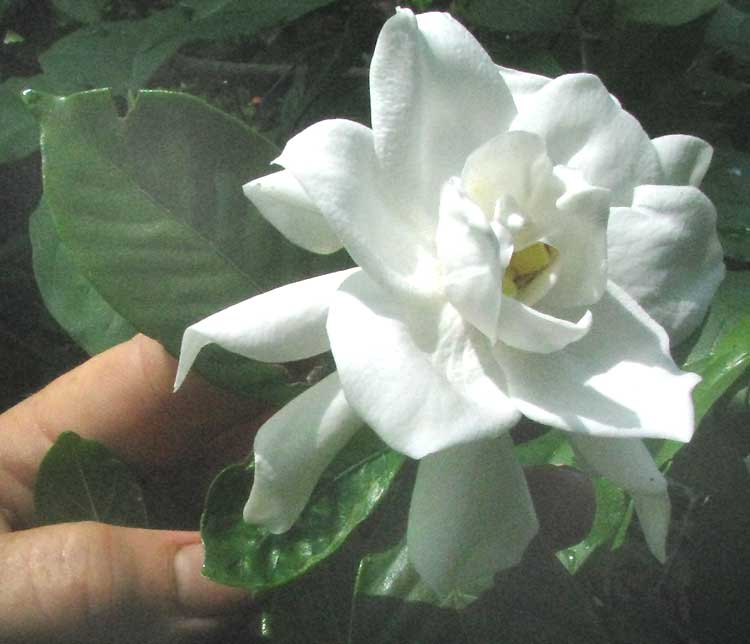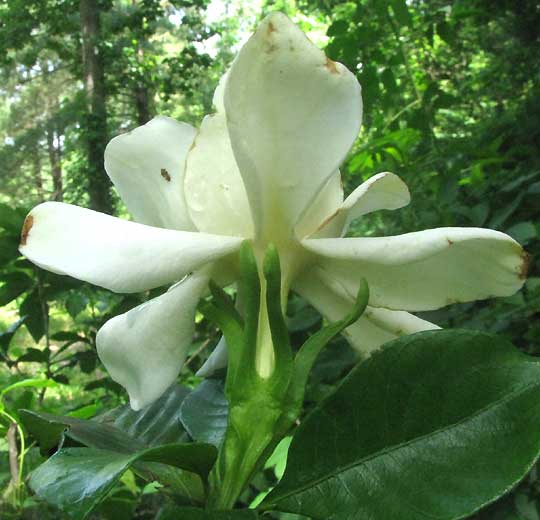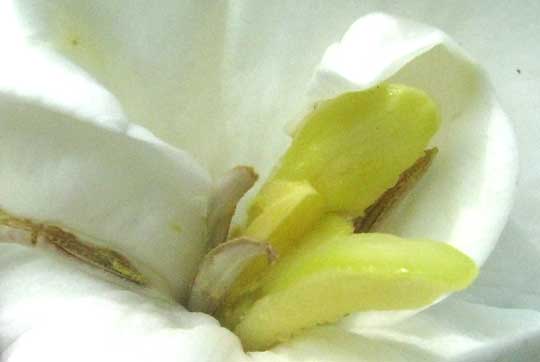Excerpts from Jim Conrad's
Naturalist Newsletter

from the May 27, 2012 Newsletter issued from the woods of the Loess Hill Region a few miles east of Natchez, Mississippi, USA
GARDENIAS FLOWERING
Especially after afternoon showers just before the fireflies start flashing and mosquitoes get bad, the delicious odor of gardenia blossoms pools around my little trailer. Sometimes a deer steps into the orchard's tall grass, flicks her tail and looks around, and I'm sure she smells it, too, but I can't imagine how she must feel, and think.
Various gardenia species exist. The commonly planted one here, sometimes called Cape-Jasmine -- the "real" Jasmine is something else completely -- is GARDENIA JASMINOIDES. The shrubs' large, white blossoms, up to four inches across (10cm), seem to glow with an inner light. A blossom at its peak of perfection, before its petals stain with brown bruises and age spots, droop and start falling off, is shown above.
One way the jasminoides species differs from others in the genus is how its calyx -- the green part below the corolla -- bears several raised ridges or "ribs," and the calyx's teeth, or sepals, are unusually long and fleshy, about as long as the corolla tube nestled inside the calyx cup, as shown below:

Several cultivars of Gardenia jasminoides exist. I'm not sure which one we have but it's a "double flowered" one. That's clear because the basic Gardenia jasminoides flower -- the blossom on the wild plant native to China -- bears five to eight lobes, not the twenty or so on our blossoms. Also, the sexual parts in our flowers' centers look a bit irregular, as shown below:

In regular Gardenia jasminoides flowers there should be five to eight stamens with anthers. Instead, we see full-sized, yellow, pollen producing anthers, two or three stunted ones, and several brown, undifferentiated items.
Frequently here we've looked at cultivar blossoms in which stamens horticulturally have been converted into petals to create flashier "double blossoms," and that's happening here. At the left in the above photo a petal bears a brown streak. The streak is a section of the petal abnormally displaying features of an anther. This is possible because during evolution stamens arose from preexisting petals, so genetic information for producing stamens is built upon information on how to make petals. If the stamen-making information of the embryonic thing destined to become a stamen is "turned off," you're left with information on how to make a flower petal, and that's what you get.
I don't like any kind of double blossom. It diminishes the uniqueness of each species' flowers in favor of a general human obsession for "bigger and gaudier" things. In the end, all double-blossom flowers end up looking the same, like brightly colored pompoms.
Still, our cultivar's flowers manage to smell good, so at least that has been left to them.